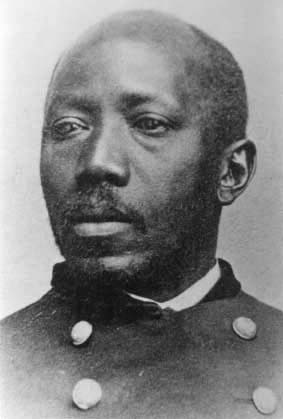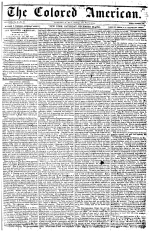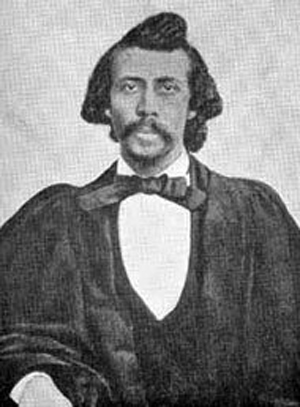Related Research Articles

Samuel Eli Cornish was an American Presbyterian minister, abolitionist, publisher, and journalist. He was a leader in New York City's small free black community, where he organized the first congregation of black Presbyterians in New York. In 1827 he became one of two editors of the newly founded Freedom's Journal, the first black newspaper in the United States. In 1833 he was a founding member of the interracial American Anti-Slavery Society.

Martin Robison Delany was an American abolitionist, journalist, physician, military officer and writer who was arguably the first proponent of black nationalism. Delany is credited with the Pan-African slogan of "Africa for Africans." Born as a free person of color in Charles Town, Virginia, now West Virginia, and raised in Chambersburg and Pittsburgh, Pennsylvania, Delany trained as a physician's assistant. During the cholera epidemics of 1833 and 1854 in Pittsburgh, Delany treated patients, even though many doctors and residents fled the city out of fear of contamination. In this period, people did not know how the disease was transmitted.

Freedom's Journal was the first African American owned and operated newspaper published in the United States. Founded by Rev. John Wilk and other free Black men in New York City, it was published weekly starting with the March 16, 1827 issue. Freedom's Journal was superseded in 1829 by The Rights of All, published between 1829 and 1830 by Samuel Cornish, the former senior editor of the Journal. The View covered it as part of Black History Month in 2021.

Lewis Woodson was an educator, minister, writer, and abolitionist. He was an early leader in the African Methodist Episcopal Church (AME) in Ohio and Pennsylvania. Woodson started and helped to build other institutions within the free African-American communities in Ohio and western Pennsylvania prior to the American Civil War.
Dorothy Sterling was an American writer and historian. After college, she worked as a journalist and writer in New York for several years, including work for the Federal Writers' Project.

The Colored American was an African American newspaper published in New York City from 1837 to 1842 by Samuel Cornish, Phillip Alexander Bell, and Charles Bennett Ray. When Cornish retired, James McCune Smith joined as co-editor.

Black science fiction or black speculative fiction is an umbrella term that covers a variety of activities within the science fiction, fantasy, and horror genres where people of the African diaspora take part or are depicted. Some of its defining characteristics include a critique of the social structures leading to black oppression paired with an investment in social change. Black science fiction is "fed by technology but not led by it." This means that black science fiction often explores with human engagement with technology instead of technology as an innate good.
The history of African-American settlement in Africa extends to the beginnings of ex-slave repatriation to Africa from European colonies in the Americas.

William Howard Day was a black abolitionist, editor, educator and minister. After his father died when he was four, Day went to live with J. P. Williston and his wife who ensured that he received a good education and learned the printer's trade. He received his bachelor's and master's degree from Oberlin College. He was a printer and newspaper editor. He fought for civil rights of African Americans a number of ways, as a journalist, teacher, and leader of the Freedmen's Bureau. He was an orator, making a speech to 10,000 newly emancipated people on what biographer Todd Mealy called the first march on Washington.

New Garden is an unincorporated community in Hanover Township, Columbiana County, Ohio, United States. New Garden is located on Ohio State Route 172, 9 mi (14 km) west of Lisbon.
Voice of the Fugitive was Canada's first Black newspaper that was directed towards freedom seekers and Black refugees from the United States.

The Baltimore Afro-American, commonly known as The Afro or Afro News, is a weekly African-American newspaper published in Baltimore, Maryland. It is the flagship newspaper of the AFRO-American chain and the longest-running African-American family-owned newspaper in the United States, established in 1892.

Robert Campbell was a Jamaican-born emigrant from the United States to Nigeria. Initially apprenticed to a printer he trained as a teacher in Spanish Town. Finding his salary insufficient in the economic turmoil of post-abolition Jamaica he emigrated to Nicaragua and Panama before settling in New York City in 1853. He found work as a printer before being employed as a science teacher and then assistant principal at the Institute for Colored Youth in Philadelphia, Pennsylvania.

The Anglo-African and The Weekly Anglo-African were periodicals published by African American abolitionist brothers Thomas Hamilton (1823–1865) and Robert Hamilton (1819–1870) in New York City during the American Civil War era. For a short period, one paper was also named the Pine and Palm.
The Provincial Freeman was a Canadian weekly newspaper founded by Mary Ann Shadd that published from 1853 through 1857. She was married to Thomas F. Cary in 1856, becoming Mary Ann Shadd Cary. It was the first newspaper published by an African-American female and Canada's first by a female of any ethnicity. The paper's motto was "Devoted to anti-slavery, temperance and general literature."
Mary Frances Vashon also known as Mary Frances Colder, and by her pen name Fanny Homewood, was an African-American journalist and an abolitionist in the 19th century. She is one of the earliest African-American female journalists.
The Elevator was a newspaper published in San Francisco from 1869 to 1874 to express the perspective of the black community. A major focus of the articles were the Fourth of July celebrations that were non-segregated as that was occasionally set aside on Independence day. The newspaper was first published under the slogan "Equality Before the Law" by Philip Alexander Bell.
The Mirror of the Times was an African American weekly newspaper in San Francisco. It was published during the mid-1850s, though its exact foundation and dissolution dates are not known. It was the first African American newspaper in the state – and possibly in the entirety of the West Coast, and it advocated against racial segregation and for Black civic engagement.
References
Citations
- ↑ Adeleke 1994a, p. 253.
- ↑ Levine 2003, pp. 1, 26.
- ↑ Levine 2003, p. 26.
- ↑ Sterling 1971, p. 81.
- ↑ Adeleke 1994b, p. 23.
- ↑ Levine 2003, pp. 27, 69.
- ↑ Levine 2003, pp. 27, 32.
- ↑ Levine 2003, p. 316.
- 1 2 Sterling 1971, p. 83.
- 1 2 Levine 2003, p. 27.
- ↑ Hutton 1993, p. 45.
- ↑ Hutton 1993, pp. 17–18.
- ↑ Sterling 1971, p. 97.
- ↑ Levine 2003, p. 1.
- ↑ Campbell 2001, p. 130.
- ↑ Sterling 1971, p. 98.
- ↑ Hutton 1993, p. 162.
Bibliography
- Adeleke, Tunde (1994a). "Black biography in the service of a revolution: Martin R. Delany in Afro-American historiography". Biography . 17 (3): 248–267. doi:10.1353/bio.2010.0267. JSTOR 23539977. S2CID 144514084.
- Adeleke, Tunde (1994b). "Race and ethnicity in Martin R. Delany's struggle". Journal of Thought . 29 (1): 19–49. JSTOR 42589366.
- Campbell, James T. (2001). "Redeeming the race: Martin Delany and the Niger Valley Exploring Party, 1859–60". New Formations (45).
- Hutton, Frankie (1993). The early black press in America, 1827 to 1860. Contributions in Afro-American and African studies. Greenwood Press. ISBN 9780313286964.
- Levine, Robert S. (2003). Martin R. Delany: A documentary reader. University of North Carolina Press. ISBN 9780807854310.
- Sterling, Dorothy (1971). The making of an Afro-American: Martin Robison Delany, 1812–1885. Doubleday & Company.